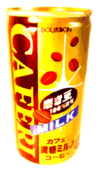|
-->
Other Chin Music    Visit our online store.  We've been hosting with ICD for over 3 years now with no hiccups. Super reliable, cheap and excellent tech support. |
When I was first contacted about writing a review for the Canned Coffee site, I figured I would just go out, buy one, and write it up. But, "a package will arrive," proclaimed Mr. Cady (Mr. Canned Coffee himself), and so it did. When I open the Japan Post yuupakku box, which looks a bit large for something that is just meant to contain a can, I am delighted to find it decorated with collages on the inside flaps. On top is an envelope, in the form of a Japanese goshuugibukuro, and unfolding it reveals instructions/suggestions on how to deal with the included items. Digging through the newspaper inside, there it is, all cozy in its bubble-wrap, a rather imposing can of Caferi bitou (just a wee bit) milk coffee from Bourbon. Oh, but it isn't alone, as the can is accompanied by an Anpanman figure — no less than the quite charming Okarinahime, which I quickly place on my desk, saving the Shokupanman ramune-like sweet for later — and a pair of protective gloves (I try putting them on to continue writing the review, but typing becomes impossible). But, back to the can, which is of course what I've been called on to review. I mentioned its imposing stature, and the reason for this is that perched on the standard-sized mini-can is a gift from Bourbon, in the shape of a miniature car from their "Japanese Sports Car Collection," complete with display case — I am granted a wicked 1971 Toyota Celica 1600GT with an all-white body and a red racing stripe that makes it go zoom! Carefully placing my newfound treasure next to the Okarinahime, whose tuneful melody I'm imagining in my mind (although it sounds curiously like the upcoming album from Taichi, More or Enough, but that could be my mind playing tricks on me — that or iTunes), it's on to the coffee. I should start by sharing this bit of info with you: Since kanji continue to be my bane, I usually select a can of coffee based on its aesthetic value, and so it's from a design perspective that I shall start this review.
|
Based on graphics, the Caferi is probably not something I would have usually chosen. A boring gold/brown theme, accompanied by flying coffee beans superimposed on a white sparkle. Ugh. The Japanese text shouts proudly "migakimame," so I should expect a drink made up of nicely polished beans (imagine me jumping up and down and doing the dance of joy). I open the can and take a whiff. The smell? Honestly, I think I'm smelling the aluminum more than anything else, since what I'm getting is a mild metallic roasted aroma. The first sip can only be described as, well, tasteless. A few more sips confirm my first impression: This is one hell of a weak-tasting coffee. I'm the first one to admit that I tend to stick to lattes and milk coffee, and that I don't usually drink very strong blend coffee. But even for me, this is as mild as coffee can get without being described as coffee-flavored milk (or even worse, coffee-flavored water). I do finish the can, and will give it props for being very gentle on the sugar intake, and coming in at a weight-watchers-friendly 20kcal. And that lack of taste I mentioned earlier? It does make it easy to get the whole thing down quite fast, which is often the point of these things, when all you're looking for is a quick caffeine kick to keep you going. Let's call it a "utilitarian" blend, then, and bring this thing to a close with a crunch of the pinkish Shokupanman candy. Finally, something with taste! When he's not busy poring over the latest design/style magazines or trying his best to pretend he's not addicted to his Nintendo DS, Jean Snow tends to write about design and culture in Japan for various online and offline publications. He also dabbles in event production, and is looking to follow up on his recent Canadian Style project. 
COMMENTS: |
Caffeinated Goods
Canned coffee is more than a drink. It's a whole fidgety, jacked-up subculture that bonds young punks, middle-aged office workers, fatigued students and even old guys in polo shirts. Enter the world, join the addiction and shop for caffeine-inspired art that would make Balzac proud.






